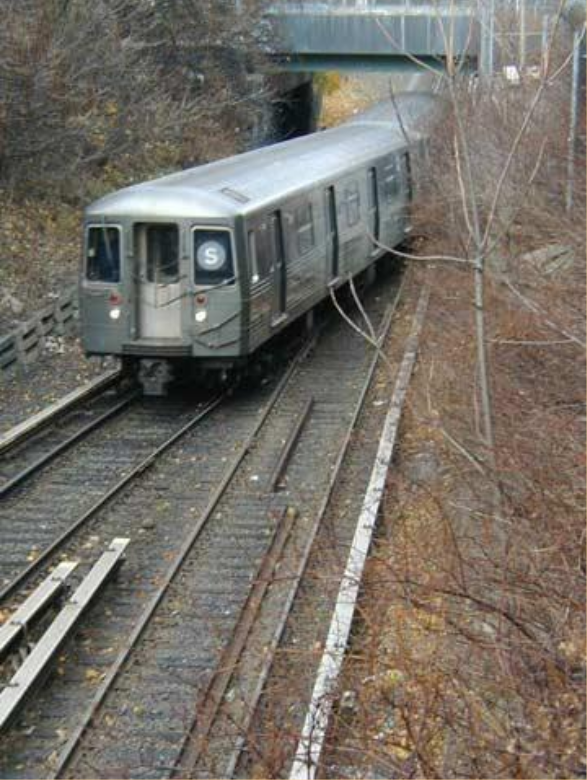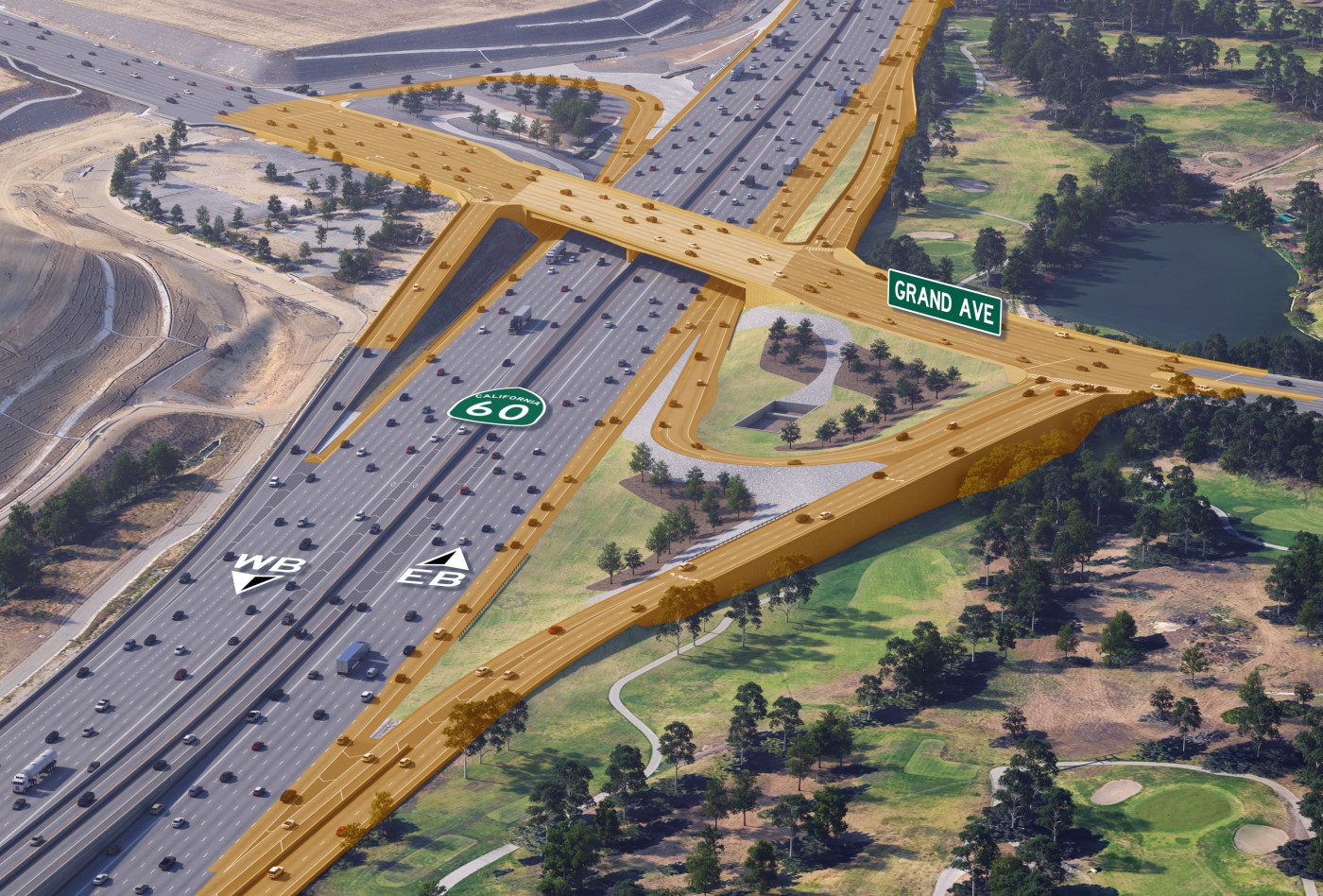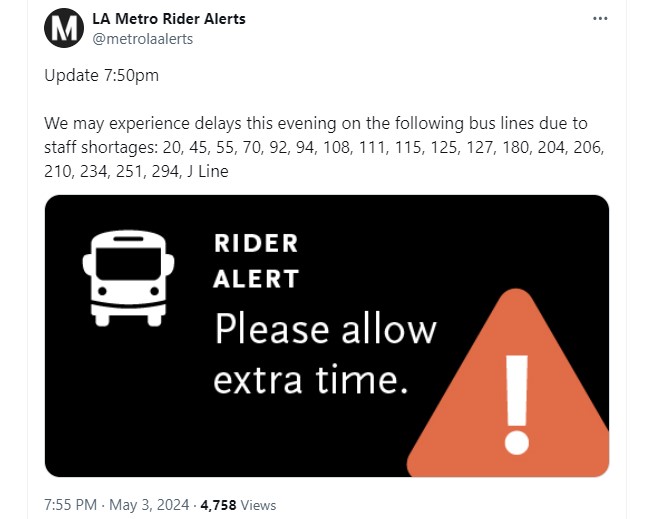Possible West Santa Ana Branch Win-Win: Heavy Rail Connection to Union Station
1:11 PM PDT on May 3, 2018
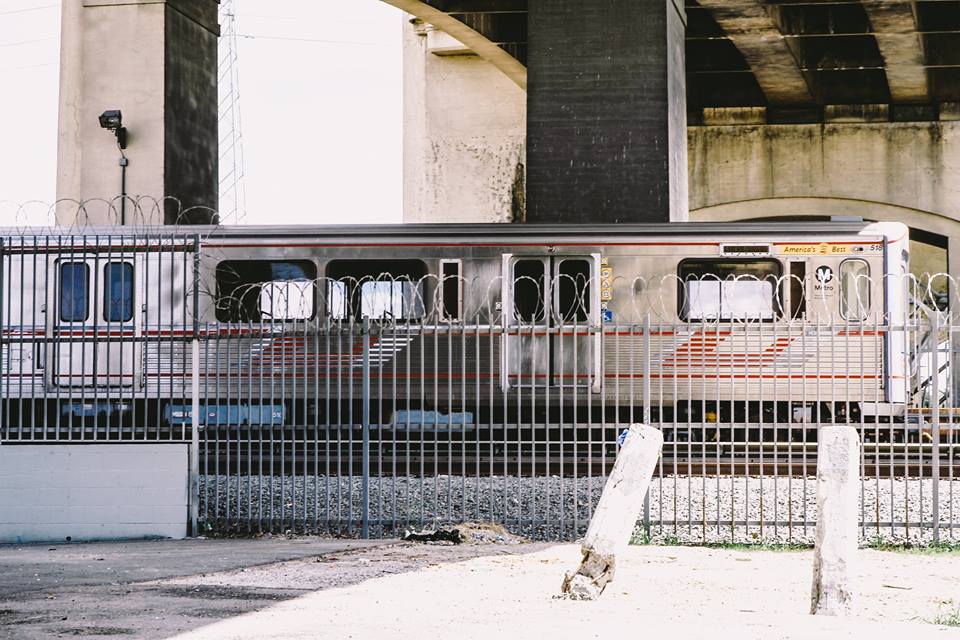
Metro is using the wrong estimates to refuse to evalutate HRT on the West Santa Ana Branch. An L.A. subway train on the trail tracks along the river, under the now-removed 6th Street bridge. Photo: Streetsblog/Rudick

Today is the last day for input on the latest round of work to narrow down potential alignments for Metro's West Santa Ana Branch Transit Corridor (WSAB) project. Metro is hosting a community meeting tonight from 6-8 p.m. in Paramount. Submit project comments in person there, or via an online comment form.
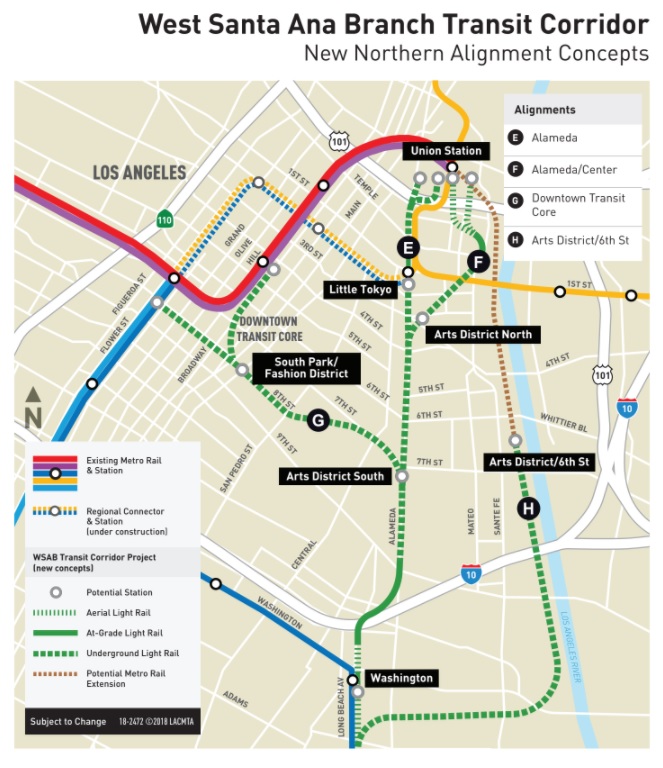
See SBLA's earlier coverage for more extensive background, but suffice it to say that the route is pretty simple south of downtown L.A., but pretty complicated through downtown. Metro is currently looking at eight different light rail (LRT) alignments downtown (see full list here or here), and none of them look easy. Seven of eight include tunnels through downtown L.A.
Metro is bending over backwards to try to stay out of the way of Little Tokyo, where folks have come out strongly against more rail construction.
Metro is considering tunneling under Little Tokyo - options E or F - in part to minimize construction impacts at ground level. This drives up cost, and it seems unlikely that minimized disruption will be enough to win over Little Tokyo which already endured years of construction for the Gold Line and the Regional Connector. The Little Tokyo community would be likely to go to court to avoid another half-decade of disruption.
If you can't go through Little Tokyo, then go around, no?
Metro has a light rail alternative west of Little Tokyo (option G) tunneling into the downtown core, which drives up costs and does not connect with Union Station.
Metro has a light rail alternative east of Little Tokyo (option H) tunneling along the river. There are potential complications about the hydrology of tunneling along a river, though Metro's cost ballpark for this option shows it as not quite as expensive as other tunnel options. What is most problematic about it is its utility. It's just not very rider-friendly, because--as currently planned--it would force transfers in the Arts District (more on that below).
With eight alternatives, none of which appear hugely promising, maybe it's time to go back to the drawing board.
Streetsblog S.F. editor Roger Rudick, who lived in downtown L.A.'s Little Tokyo for many years, has long pressed for another alternative: run the same heavy rail equipment used on the L.A. Red/Purple Line subway on the WSAB and connect the two lines in the Arts District. This is similar to Option H, but with no forced transfer and no tunnel. WSAB, from the rider perspective, becomes part of the subway. Not only do passengers get a one-seat ride to Union Station, but they can ride directly all the way to North Hollywood, Koreatown, and West L.A. The problem of getting through downtown is solved, since the WSAB simply connects to the end of the subway storage yards at 6th Street (see lead photo).
We Streetsblog editors are not engineers or planners, but we've checked and double-checked this idea with some planners and engineers at Metro and elsewhere, and it appears feasible. The option was overlooked in the early days of planning on this line, because politics favored conventional L.A. standard light rail, which is narrower than the L.A. subway trains and doesn't align with the same platforms. L.A. Light Rail also uses overhead wire, while the subway uses third rail, so the two systems are not compatible.
Joining the subway with the WSAB has the potential to be a win-win-win for Metro riders, and for the communities the WSAB would serve.
Where would WSAB heavy rail go?
Our WSAB heavy rail proposal would run along the L.A. River, east of Little Tokyo, sharing some features of Metro's easternmost alignment (option H).
The heavy rail WSAB would extend the Red/Purple Line east out the back of Union Station into Metro's Division 20 Metro rail yard located between the downtown L.A. Arts District and the river, south of First Street. Metro is already working to retool this yard as part of its Division 20 Portal Widening and Turnback Facility project, which lays the groundwork for an Arts District Station for the Red/Purple Line.
WSAB heavy rail could extend these tracks south - all the way to Artesia.
The subway tail tracks already extend south of 6th Street. Below that, the WSAB would continue south along the L.A. River along a right-of-way currently used by Amtrak to reach its shops and car-wash facility. There's actually a pretty open ROW along this route, some portions currently used for parking lots.
Where Amtrak turns east across the river near Washington Boulevard, the WSAB would continue on a flyover over the Alameda Corridor freight line at Redondo Junction, and then take an abandoned freight ROW into the city of Vernon. From there it could include a possible station in Vernon as the line continues south on an existing rail right of way between Santa Fe Avenue and Soto Street.
Continuing south-southeast, the WSAB heavy rail would follow Metro's proposed alignment. It would reach the planned Huntington Park Station at Pacific Avenue and Randolph Street and would continue along the planned WSAB alignments all the way out to the city of Artesia.
Benefits of Heavy Rail vs. Light Rail
There are several advantages to running heavy rail on the WSAB:
- Cheaper to build: No, really. By eliminating the need for boring a new ROW tunnel through downtown (and, in option F, a bridge over the 101) to reach Union Station, this should cost less than LRT. Yes, there will probably need to be a few more flyovers and a few more streets closed on the WSAB branch south of Redondo Junction, but these additional costs will be more than offset by the elimination of an all new ROW through downtown. Metro's tunneling under 100+ year old streets downtown has meant encountering "unforeseen discoveries" leading to serious cost overruns. Unknowns and overruns would be likely on all of Metro's latest proposals (options E, F, G, and H), all of which include significant downtown tunnels. (Another less quantifiable cost factor would be delays from lawsuits any alignment through Little Tokyo will invite).
- Higher capacity: Red/Purple Line heavy rail trains have quite a bit more passenger capacity than Metro light rail trains. There are lots of calculations that go into it, but Metro LRT can carry maximum loads around 14,000-19,000 passengers per hour, while Metro heavy rail maximum capacity is around 100,000+ passengers per hour.
- Faster: Red/Purple Line trains accelerate faster and run faster than LRT trains. The proposed eastern heavy rail alignment would be shorter and straighter than Metro's other alternatives. These would combine to provide riders faster trip times.
- Potential Phasing: Initial service could potentially be brought online faster, since segments of the line could be built from the Arts District going south, and opened in increments. An early phase could consist of adding station platforms along the existing tracks in the Arts District. The trains, maintenance facilities, operators, etc. are already in place.
Benefits to Communities
There are big benefits for the communities along the 20-mile West Santa Ana Branch transit corridor route.
The South East L.A. County cities - the Gateway Cities from Huntington Park to Artesia - would get a faster and more direct one-seat ride into Union Station, and through downtown into Red/Purple Line destinations in the Valley and on the Westside. Heavy rail would mean more capacity for ridership, especially needed to serve population-dense southeast cities.
The downtown L.A. Arts District would get its (long sought-after but never quite funded) Red/Purple Line station. Instead of a limited utility dead-end spur, a WSAB Arts District station would offer community connections both north and south.
Little Tokyo would avoid additional Metro construction.
Other Costs and Questions
Heavy Rail would need longer platforms.
Just because there is existing rail ROW, doesn't mean there are no costs. But surface costs should be significantly less than underground ones.
The ROW will need to be fenced in and grade crossings should probably be eliminated, as was done on Bay Area Rapid Transit (BART) in areas where it runs on the surface. This is because L.A.'s heavy-rail subway equipment is powered by third rail, which could be a potential hazard to anyone trespassing on the tracks. However, there's nothing unusual about running third-rail powered, heavy rail subway trains above ground (see the example from NYC below).
Longer routes (like those coming soon as part of the Regional Connector) will require logistical planning by Metro, which will likely consider running some shorter trips. This is true under any scenario, and true for all rail and bus lines.
There are lots of details to work out for this proposal, and probably some unforeseen consequences. But, with Metro facing eight potentially difficult WSAB alternatives, we figured it was time to bring this idea up again and get it into the discussions.
Stay in touch
Sign up for our free newsletter
More from Streetsblog Los Angeles
This Week In Livable Streets
Bike Month continues, Metro 91 Freeway widening, Destination Crenshaw, Culver City Bus, Santa Monica MANGo, Metro bike lockers, Metro Sepulveda Transit, and more
San Fernando Valley Bus/Bike Updates: G Line, Roscoe Bus Lanes, Laurel Canyon Bike Lanes
Short newly protected bike lane on Laurel Canyon Blvd, extensive NSFV bus improvements under construction this month, and scaled-back G Line plans should get that project under construction this summer
No, L.A. City Does Not Always Add Required ADA Ramps During Resurfacing, But They Should
StreetsLA GM Keith Mozee "Any time we do street resurfacing, it is considered an alteration, which requires ADA ramps to be installed."
